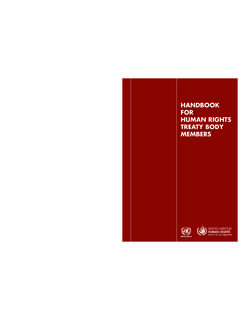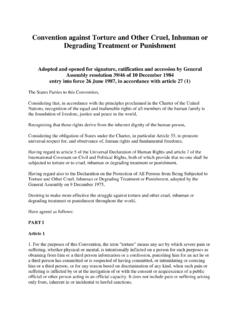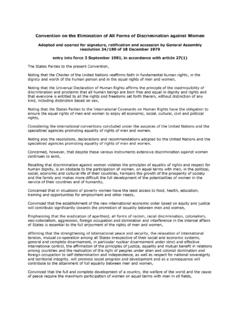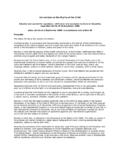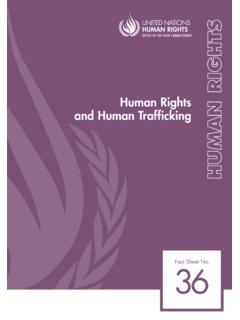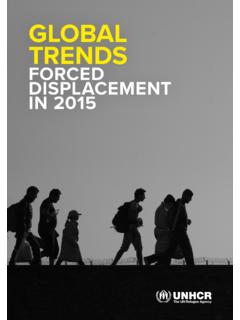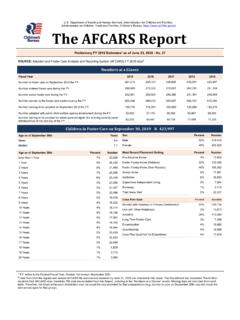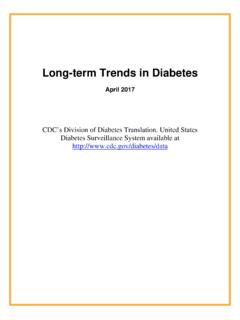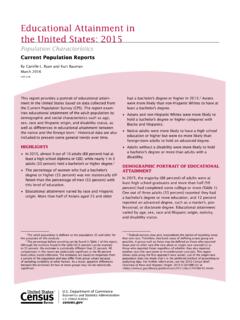Transcription of Overcrowding and Overuse of Imprisonment in the United ...
1 Overcrowding and Overuse of Imprisonment in the United States American Civil Liberties Union (ACLU). Submission to the Office of the High Commissioner for Human Rights May 2015. This idea of total incarceration just isn't working.. Supreme Court Justice Anthony Kennedy, March 23, 2015. I. Overcrowding and the Overuse of Imprisonment in the United States While the Overuse of Imprisonment is a problem of endemic proportions around the world, the human rights violations associated with this practice are particularly egregious in the context of the United States.
2 With an incarceration rate five to ten times that of other western democracies, the United States has less than five percent of the world's population, but our country's prisoners account for one quarter of the global prison population. Indeed, the incarcerates more people in absolute numbers and per capita than any nation in the world, including the far more populous China, which rates second, and Russia, which rates Over the past 40 years, the number of people held in prisons and jails in the United States per capita has more than quadrupled, with the total number of people incarcerated now surpassing Since 1970, the prison population has risen 700%, a rate that far outpaces that of the general population and crime rates.
3 Every state and the federal government have seen a massive increase in inmate populations in recent Currently, one in 99 adults are living behind bars in the , and one in 31 adults are under some form of correctional control, such as prison, jail, parole, or Existing facilities have been overcrowded far beyond capacity, with prisoners sleeping in gyms and hallways or triple- and quadruple-bunked in cells. This explosive growth has reverberated far outside the prison walls: one out of every four Americans has a criminal record, which can impose tremendous obstacles to finding employment, securing loans, and obtaining Across the country, young Black men living in neighborhoods of concentrated disadvantage are disproportionately incarcerated and under correctional control.
4 This phenomenon the excessive use of incarceration and correctional control, especially among poor people and people of color is commonly referred to as mass incarceration. 1. Mass incarceration in the United States raises serious constitutional and human rights concerns. The human rights violations inherent in the system of mass incarceration play out on a number of fronts: from racial disparities in arrests, convictions, and sentencing; to draconian sentences mandating that non-violent offenders serve the rest of their lives behind prison walls; to the heightened impact of incarceration on vulnerable populations such as children and the mentally ill.
5 II. Main Causes of Overcrowding and the Overuse of Imprisonment in the United States The explosive growth of the jail and prison population since the 1970s is the inevitable consequence of more than four decades of tough-on-crime policies. Since the mid-1970s, state and federal legislators have passed laws creating draconian sentencing and parole schemes designed to keep ever-increasing numbers of people in prison for decades. These policies include mandatory minimum sentencing, which forces judges to issue severe sentences regardless of individual factors meriting leniency, and three-strikes laws, which expand the number of crimes subject to life and life-without-parole sentences.
6 These policies have increased the number of people imprisoned and the lengths of their imprisonments, as well as limited opportunities for release, causing the population of federal and state prisoners to soar. Two factors primarily determine the number of people in prison: the number of admissions and the length of stay, meaning the amount of time a person spends incarcerated. 6 When these numbers rise, the number of people behind bars increases. In the United States, both admissions and lengths of stay have increased rapidly in state and federal prison systems for decades.
7 Increases in felony charges by prosecutors, as well as increases in parole and probation revocations for technical and other low-level violations, drove admissions up,7 while severe sentencing practices such as mandatory minimums, three-strikes and other habitual offender laws, and long sentencing ranges with limited possibilities for release have dramatically elongated length of stay. a. The War on Drugs and Mandatory Minimum Sentencing Laws Beginning in the mid-1970s and increasing throughout the 1980s and 1990s, in response to modest increases in crime rates and reports about the prevalence of drug abuse and drug-related crime, lawmakers around the country enacted harsh mandatory minimum sentencing laws designed to severely punish the manufacture, use, and sale of drugs, among other crimes.
8 Mandatory minimum laws require automatic prison terms for those convicted of certain federal and state crimes. These inflexible, often extremely lengthy, one-size-fits-all sentencing laws prevent judges from tailoring punishment to the individual and the seriousness of the offense, 2. barring them from considering factors such as the individual's role in the offense or the likelihood he or she will commit a subsequent crime. Mandatory minimum sentences defeat the purpose of sentencing by reducing judicial discretion and instead handing it to prosecutors, who then use the threat of lengthy sentences to frustrate defendants seeking to assert their constitutional rights.
9 Under federal law, most mandatory minimum sentences apply to drug crimes8 and are based on the weight of the drug(s) involved; these sentences start at five years for certain drug possession offenses and increase to life without Three federal drug offenses can result in life without parole, even if the offenses are relatively minor. For example, a federal conviction for possessing 50 grams of methamphetamine carries a mandatory life-without-parole sentence if the defendant has previously been convicted of two other felony drug offenses, which can be as minor as selling personal amounts of In addition, in 1984, Congress created the Sentencing Commission, which established federal Sentencing Guidelines that apply in all federal cases and were intended to reduce sentencing disparities.
10 The guidelines, however, set harsh mandatory sentences that lengthened prison times for a range of crimes and eliminated judicial discretion to craft individualized sentences. Though the mandatory nature of the guidelines was found unconstitutional by the Supreme Court in United States v. Booker in 2005, federal judges must continue to use them to guide their sentencing Moreover, Booker is not retroactive, which means that there are thousands of federal offenders sentenced before 2005 still serving mandatory prison sentences handed out under the mandatory guidelines even in cases where the sentencing judge objected to the mandatory sentence required at the time.
